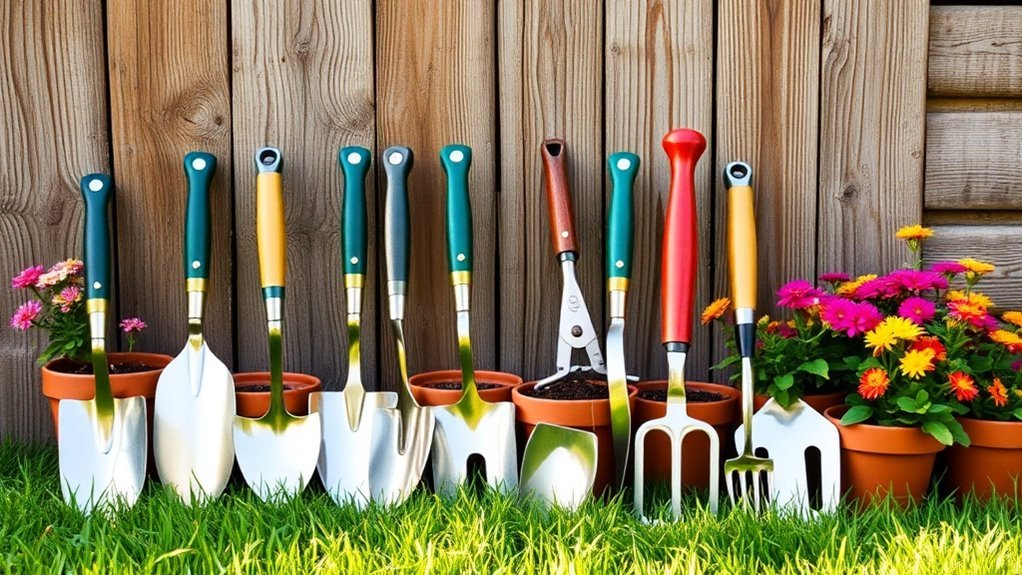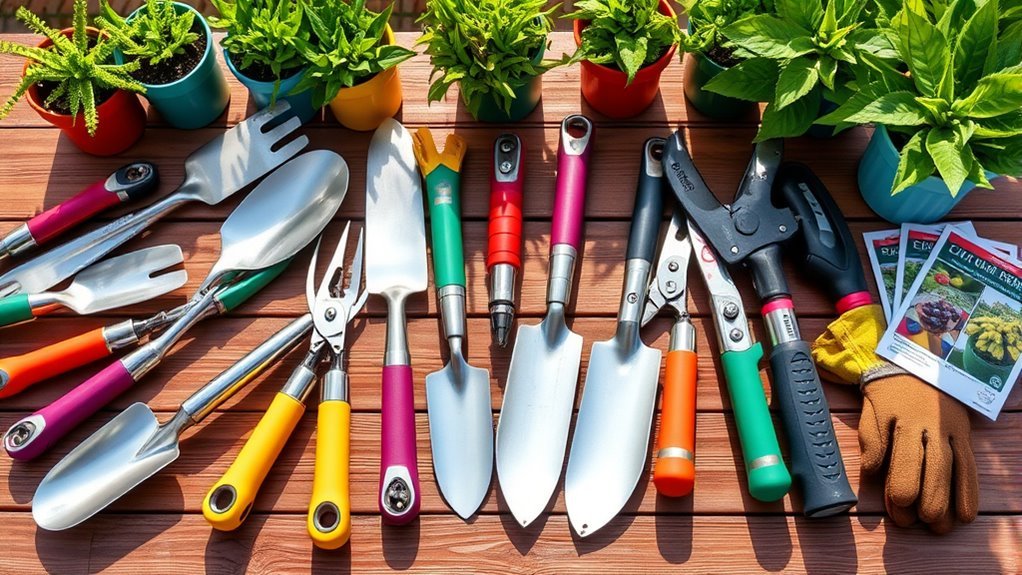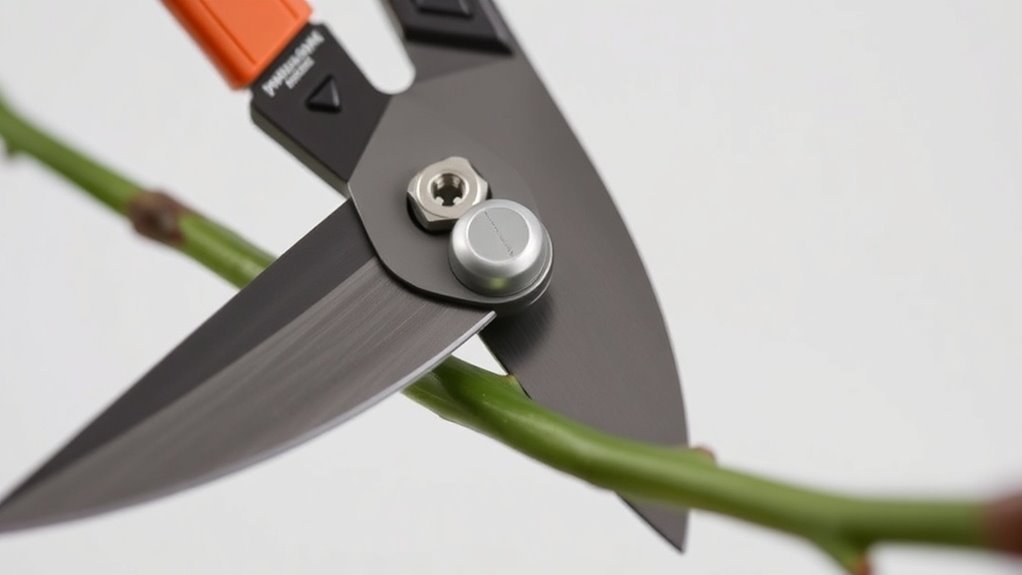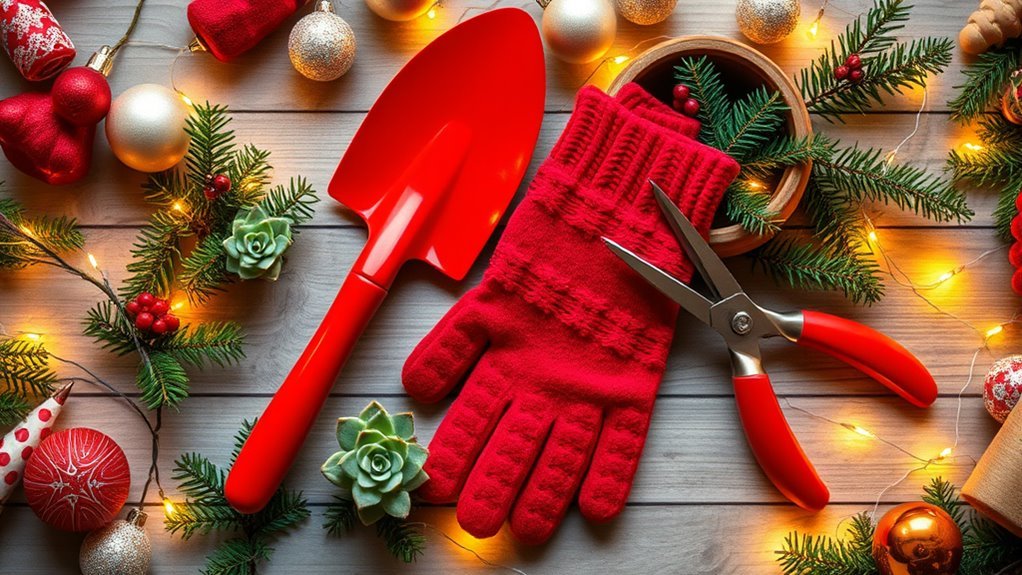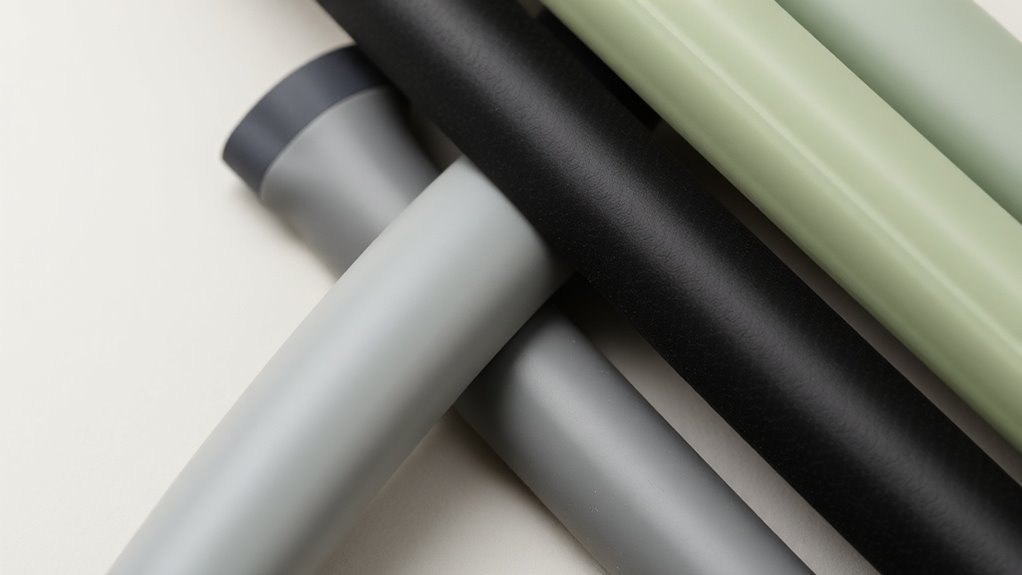Ergonomics in Garden Tool Design
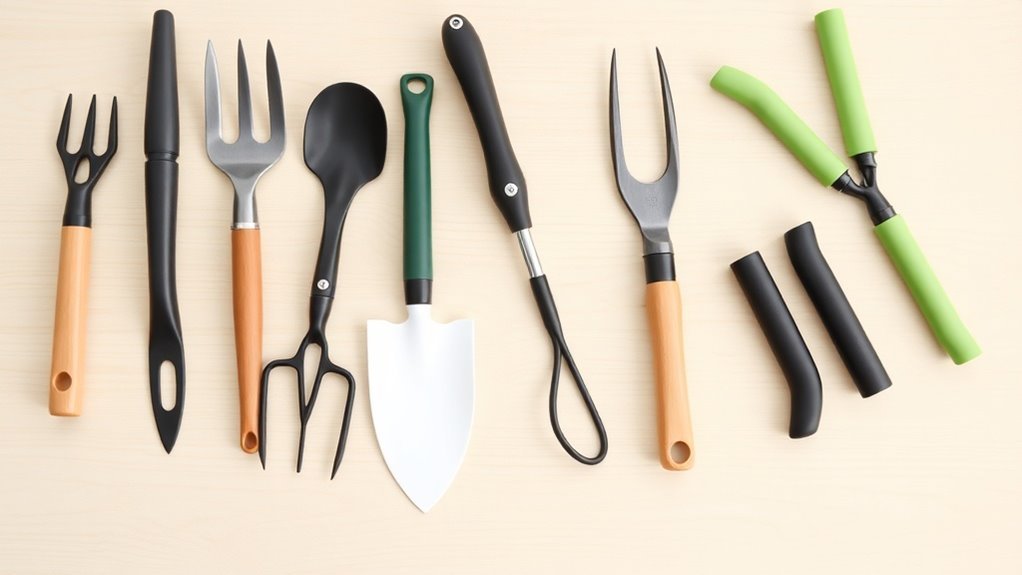
In garden tool design, ergonomics is essential for your comfort and efficiency. Well-designed tools help maintain your natural posture, reducing strain on your muscles and joints. Features like adjustable grips, balanced weight, and vibration dampening enhance control and minimize fatigue. With these designs, you can spend more time gardening without discomfort. If you want to learn how these principles improve your gardening experience even further, you might want to explore more about their impact.
Key Takeaways
- Ergonomically designed garden tools maintain natural posture and reduce muscle strain, enhancing comfort during gardening tasks.
- Adjustable features in tools cater to various user heights, improving fit and reducing discomfort while gardening.
- Grips made from rubber or foam offer better cushioning, enhancing control and decreasing hand fatigue during extended use.
- Lightweight designs and well-distributed weight minimize fatigue, allowing gardeners to work longer without experiencing discomfort.
- User-centric designs integrate feedback to boost productivity, making gardening more enjoyable and efficient while prioritizing user health.
The Importance of Ergonomics in Gardening
When you’re out in the garden, you mightn’t realize how much your comfort affects your enjoyment and efficiency. Ergonomics plays an essential role in gardening, as it helps you maintain a natural posture while working.
Using tools designed with your body in mind reduces strain on your muscles and joints, making the experience much more pleasant. When you’re comfortable, you can focus on your tasks, whether it’s planting, weeding, or pruning.
Plus, a well-designed tool can enhance dexterity and control, leading to better results without tiring you out. Prioritizing ergonomics means you’ll love gardening even more, allowing you to spend hours outside without discomfort or fatigue. Thoughtful tool design not only reduces user fatigue but also enhances productivity and efficiency in your gardening tasks.
Making wise choices about tools can transform your gardening experience.
Key Ergonomic Principles in Tool Design
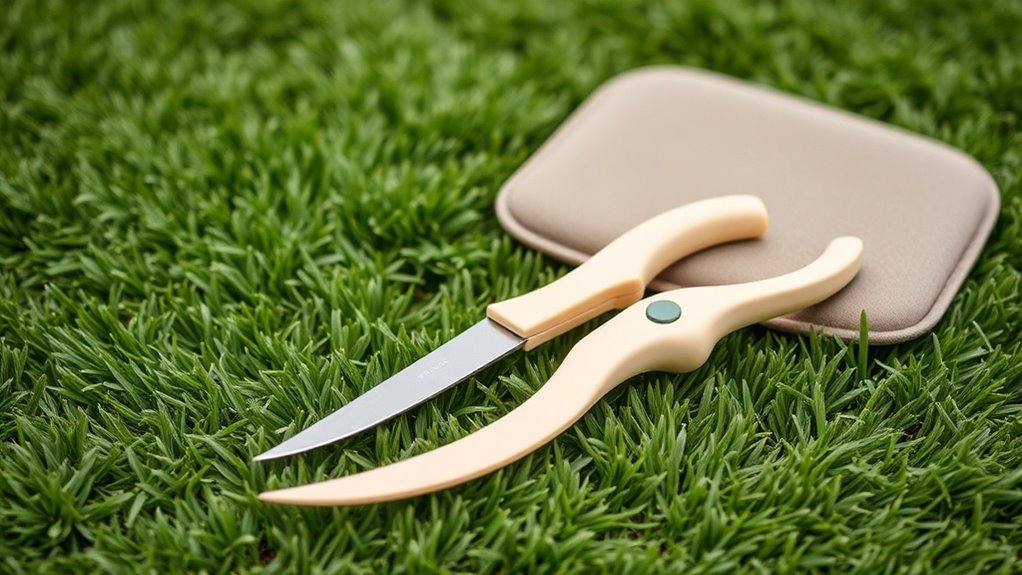
Effective ergonomic design in garden tools revolves around a few key principles that enhance usability and comfort.
By focusing on these principles, you can make gardening more enjoyable while minimizing strain.
- Weight Distribution: Tools should distribute weight evenly to reduce fatigue.
- Adjustability: Features that allow you to adjust tools to your specific height or reach can improve posture.
- User-Friendly Interfaces: Simple controls and intuitive designs streamline operation, making tasks easier.
- Durability and Maintenance: Tools should be made from durable materials that require minimal upkeep, ensuring they last.
Incorporating these ergonomic principles into garden tool design allows you to work more efficiently and comfortably, so your gardening experience can be more rewarding. Additionally, advancements in modern tool design have played a significant role in enhancing the ergonomics of gardening tools, further improving user experience.
Hand Tools: Grips and Handles
Many gardeners underestimate the importance of grips and handles in hand tools, yet these components can markedly impact comfort and efficiency.
A well-designed grip can reduce strain on your hands and wrists, allowing you to work longer without fatigue. Look for tools with ergonomic shapes that conform to the natural position of your hand.
Materials like rubber or foam can provide better cushioning and a non-slip surface, ensuring you maintain control even when wet. Also, consider handle size; it should fit your hand comfortably. If it’s too small or large, it can lead to discomfort over time.
Choosing grips made from rubber or foam and the right handle size can significantly enhance your gardening comfort and control.
Investing in good grips and handles ultimately enhances your gardening experience, making your tasks feel less like a chore and more enjoyable. Additionally, a well-designed handle can significantly reduce the risk of injury, thus promoting safer gardening practices.
Power Tools: Balancing Comfort and Performance
While power tools can greatly boost your gardening efficiency, they must also prioritize your comfort to prevent fatigue and injury.
Finding the right balance between performance and comfort is essential. When using power tools, consider the following features:
- Ergonomic grips: Designed to fit your hand, reducing strain during long use.
- Vibration dampening: Minimizes hand fatigue and potential nerve damage.
- Adjustable settings: Let you customize power levels according to your task, enhancing control.
- Lightweight design: Easier maneuvering reduces the physical toll on your body.
Incorporating sound-dampening materials can further enhance user comfort while operating power tools.
Reducing Strain: The Role of Tool Weight
When it comes to gardening, the weight of your tools can noticeably impact your overall comfort and performance. Heavier tools can lead to increased fatigue, especially during long sessions, making you less efficient and more prone to strain or injury.
You’ll want to look for lightweight options that still offer durability and strength. Materials like aluminum or high-strength plastics can create tools that feel much lighter without compromising effectiveness.
When selecting your tools, consider how their weight affects your grip and posture, as it directly influences your reach and control. Choosing the right weight for your tools not only helps minimize strain on your muscles and joints but also enhances your gardening experience, allowing you to focus on enjoying your time outdoors. Additionally, using hand tools can provide greater precision and control, allowing for a more enjoyable experience while gardening.
Adaptive Tools for Different Needs
When it comes to gardening, not every tool fits every need.
You’ll find that ergonomic handle options and adjustable tool lengths can make a huge difference in your comfort and efficiency. Additionally, selecting the right tools for different soil types is crucial for improving soil health and plant growth.
Let’s explore how these features can enhance your gardening experience.
Ergonomic Handle Options
As you explore ergonomic handle options in garden tools, you’ll find that adaptive designs can greatly enhance your gardening experience.
Choosing the right handle can reduce strain and improve your control during use. Ergonomic handles come in various shapes and materials tailored to your needs.
- Contoured grips can provide comfort for extended periods.
- Soft, non-slip materials enhance grip, reducing fatigue.
- Offset handles help alleviate wrist strain, making tasks easier.
- Adjustable handles can accommodate different hand sizes and preferences.
Adjustable Tool Lengths
Adjustable tool lengths offer significant advantages for gardeners of all ages and abilities, ensuring that everyone can work comfortably and efficiently.
With tools that extend or shrink, you can customize the length to suit your height and the specific gardening task at hand. This flexibility reduces strain on your back and arms, making gardening more enjoyable.
Whether you’re planting seedlings or pruning tall branches, the right tool length can enhance your reach without compromising your posture. Plus, these adaptable tools often feature easy-lock mechanisms that let you switch lengths quickly.
They’re especially beneficial for families, as one tool can accommodate different users, ensuring everyone has a productive gardening experience without unnecessary discomfort.
Embrace adjustable lengths to optimize your gardening journey!
Future Trends in Ergonomic Garden Tool Design
Although gardening has long been seen as a relaxing pastime, advancements in ergonomic design are set to reshape how you experience this beloved activity.
As technology continues to evolve, expect to see tools tailored for comfort and efficiency, making your gardening tasks easier and more enjoyable.
- Smart tools with built-in sensors to monitor posture and provide real-time feedback
- Lightweight materials that reduce strain without sacrificing durability
- Adjustable grips for customized handling, ensuring better control and less fatigue
- Eco-friendly designs that promote sustainability while keeping user comfort in mind
These innovations promise to not only enhance your productivity in the garden but also prioritize your health and well-being, helping you cultivate your green thumb pain-free.
Questions
How Can I Choose the Right Ergonomic Tools for My Gardening Style?
To choose the right ergonomic tools for your gardening style, assess your needs, consider grip comfort, weight, and size. Test various options in-store, and prioritize tools that reduce strain while enhancing your gardening experience.
Are Ergonomic Tools More Expensive Than Regular Garden Tools?
Yes, ergonomic tools often come with a higher price tag than regular ones due to their specialized design and materials. However, investing in them can help prevent injuries and make your gardening experience more enjoyable.
Can Children Use Ergonomic Garden Tools Safely?
Yes, children can use ergonomic garden tools safely, as they’re designed to be lightweight and easy to grip. Just guarantee they’re properly supervised and using tools appropriate for their size and skill level for safety.
What Materials Are Best for Ergonomic Tool Handles?
Rubber and soft-grip materials are best for ergonomic tool handles, as they provide comfort and reduce strain. Lightweight metals or composites can enhance usability, while ensuring durability. Choose materials that feel good in your hands.
How Often Should I Replace My Ergonomic Garden Tools?
You should replace your ergonomic garden tools every 5 to 7 years. Curiously, studies show that 30% of gardeners don’t replace their tools regularly, which can lead to discomfort and decreased efficiency over time.
Conclusion
So, as you carefully wield your ergonomically designed trowel, remember: who needs a comfortable grip when you can make your hand feel like a brick? Of course, we’re all for straining your back in style! Why not embrace the joys of a heavy, unwieldy tool that’s as fashionable as a 90s phone? Just think of it as a workout! So, happy gardening, and may your quest for comfort be as successful as finding a needle in a haystack!

